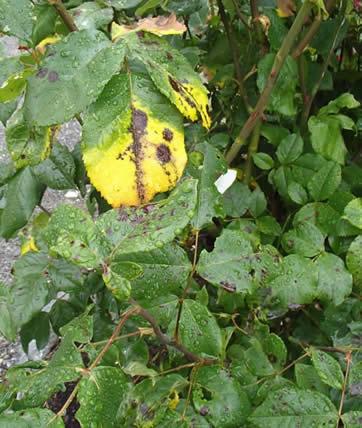by Vancouver Island Master Gardeners Association
Question: What are the black spots on my roses?
Answer: Black Spot or Diplocarpon rosae is the most serious disease of roses today. It affects the leaves and often the twigs/canes, and directly affects plant vigor. It stresses the plant and can sufficiently weaken it to a point where it becomes susceptible to other diseases and problems. It occurs in cool moist weather and persists with humidity and warmth although is somewhat assisted by July and August’s hotter days.
The first indication of a problem is the tiny black spots that appear on the upper surface of the rose leaves. The surrounding area around the black spot turns yellow, spreads, and the leaf senesces or falls off. It starts at the bottom of a plant and moves its way to the top. The plant generates new leaves which in turn become infected from the dropped leaves or infected canes and the process stars anew on new growth. This constant renewal of leaves puts the plant under consistent stress and thereby reduces the vigor of the plant over a short time.
The fungus itself overwinters in the infected dropped leaves and occasionally the twigs and canes of the rose. It can also be windborne, so encourage your neighbours to clean up their roses as well. Rain or overhead sprinklers disperse via splashing the infected spores to the lower plant structures and the process begins. Leaves wet for more than a few hours enable the spores to take hold.
Prevention: Diligent and thorough fall/winter clean-up of old leaves is imperative. There are two schools of thought on composting the old rose leaves – one school says don’t they will infect your new soil and pass on the problem. The other argues that if compost is done well and proper the heat will kill off that spore. If you suspect you may have questionable heat concerns, don’t compost!
Mulch well, prune off any suspected canes or twigs that may be infected (purple blotches or blackened areas). Keep roses dry. Think of them as you would tomatoes and water from the bottom, not overhead. Prune for good air circulation through the centre of the plant. Move them to a sunnier spot if need be; this will assure the leaves dry in the daylight sooner and don’t give the spore time to infect. Water in the morning versus evening to give leaves a chance to dry instead of sitting wet. Clean your pruners between roses! Direct contact is a sure fire way to spread it around. Simple rubbing alcohol is sufficient. Plant resistant types, … with a caveat that there are many different strains of black spot and any given rose may be more susceptible to one type than another so this may not be as applicable as the other prevention options. There is some evidence to suggest that the “older” roses are much more naturally resistant, so research to see how long your rose choices have been around.
Treatment options: Neem oil has had some positive effects but may be hard to find. Sulfur sprays – caution as it is easy to overdo.

Photo courtesy: Dr. Linda Gilkeson.
For gardening questions in the growing season, contact the Gardening Advice Line.

